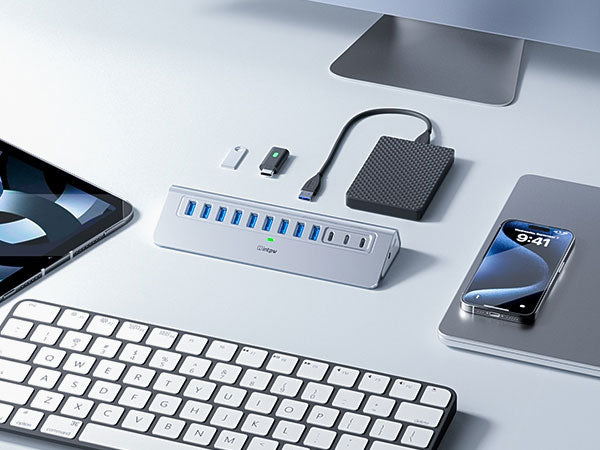
What Is a Docking Station? The Essential Tool for Creating a High-Performance Workspace
, by USintpw, 6 min reading time

, by USintpw, 6 min reading time
In the digital age, our laptops and tablets are more powerful and portable than ever. But portability often comes with trade-offs: limited ports, small screens, and constrained multitasking capabilities. That’s where a docking station steps in. This essential tool transforms your laptop into a full-fledged workstation, offering unmatched convenience, efficiency, and flexibility.
This blog will explain what a docking station is, why it’s important, and how it can help you create a high-performance workspace.
A docking station is a hardware device that connects your laptop or tablet to multiple peripherals through a single cable or port. Think of it as a central hub that expands your device’s connectivity. With a docking station, you can link your computer to external monitors, keyboards, mice, printers, external storage, and more—all at the same time.
Docking stations come in various shapes and sizes. Some are compact and portable, while others are designed for permanent desk setups. They typically connect to your laptop via USB-C, Thunderbolt, or older standards like USB-A. Many modern docks also offer charging capabilities, keeping your laptop powered while you work.
Laptops are designed for portability, but they’re not always ideal for complex workflows. A docking station fills this gap by providing extra ports and connections. With it, you can use multiple screens, attach high-speed external drives, or connect audio and video equipment without any hassle.
For professionals working from home or in an office, a docking station allows you to create a desktop-like experience with your laptop. You can add a large monitor, a full-sized keyboard, and a mouse, giving you the comfort and efficiency of a desktop while keeping the flexibility of a laptop.
Managing multiple devices and cables can get messy. A docking station reduces clutter by consolidating all your connections into one place. You no longer need to plug and unplug devices every time you move your laptop. Just connect it to the dock, and you’re ready to go.
Multiple Ports:
Docking stations typically offer a variety of ports, including:
Power Delivery:
Many docking stations can charge your laptop and other devices simultaneously. This eliminates the need for multiple chargers and keeps your workspace tidy.
Dual or Triple Monitor Support:
A significant advantage of docking stations is their ability to support multiple external displays. Some high-end docks allow you to connect two or three monitors, improving your multitasking capabilities.
High-Speed Data Transfer:
Modern docking stations support high-speed data transfer rates, making it easy to move large files between external drives and your computer.
Compact Design:
Portable docking stations are lightweight and easy to carry, making them ideal for frequent travelers.
Using a docking station is simple and straightforward. Here’s how to get started:
With a docking station, you can easily multitask across multiple screens. For example, you can have your email open on one monitor, a video call on another, and a spreadsheet on a third. This setup saves time and reduces the need to toggle between windows.
Working on a laptop for long hours can strain your neck and back. A docking station lets you connect to external monitors that can be positioned at eye level. Pair this with a full-sized keyboard and mouse, and you’ve created an ergonomic workspace that reduces physical discomfort.
In meetings, docking stations are invaluable. You can connect your laptop to a large screen or projector for presentations while keeping your notes and communication tools accessible on another screen. This makes collaboration smoother and more engaging.
Docking stations cater to professionals with diverse needs:
A docking station consolidates all your devices into one hub, making it easy to connect and disconnect without disrupting your workflow.
When selecting a docking station, consider the following factors:
Compatibility:
Ensure the dock supports your laptop model and operating system. Most modern docks are universal, but it’s best to check for compatibility with your device.
Port Options:
Identify the peripherals you use most and choose a dock that offers the necessary ports. For example, if you need dual monitors, look for a dock with two HDMI or DisplayPort outputs.
Power Delivery:
Choose a dock that can charge your laptop and other devices. Check the wattage to ensure it meets your laptop’s requirements.
Size and Portability:
If you travel frequently, a compact and lightweight dock may be more practical. For a permanent desk setup, a larger dock with more ports may be ideal.
Budget:
Docking stations vary widely in price, depending on their features. Determine your needs and find a dock that fits your budget.
A docking station is more than just an accessory—it’s a tool that can transform your laptop into a high-performance workspace. By expanding your device’s connectivity, improving ergonomics, and streamlining your workflow, a docking station helps you work smarter and more comfortably.
Whether you’re a professional, student, or creative, investing in a docking station is a step toward unlocking your laptop’s full potential. Choose the right dock for your needs, set it up, and experience the convenience and efficiency it brings to your daily tasks.

Subscribe to our emails